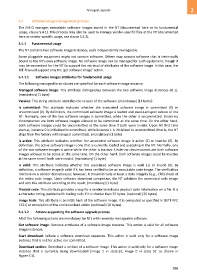Page 1009 - 5G Basics - Core Network Aspects
P. 1009
Transport aspects 2
S.4 Software image management process
The ME-O manages executable software images stored in the NT (documented here as its fundamental
usage, clause S.4.1). This process may also be used to manage vendor-specific files at the NT (documented
here as vendor-specific usage, see clause S.4.2).
S.4.1 Fundamental usage
The NT contains two software image instances, each independently manageable.
Some pluggable equipment might not contain software. Others may contain software that is intrinsically
bound to the NT's own software image. No software image can be managed for such equipment, though it
may be convenient for the NT to support the retrieval of attributes of the software image. In this case, the
ME-R would support only the 'get software image' action.
S.4.1.1 Software images attributes for fundamental usage
The following manageable attributes are specified for each software image instance:
Managed software image: This attribute distinguishes between the two software image instances (0, 1).
(mandatory) (1 byte)
Version: This string attribute identifies the version of the software. (mandatory) (14 bytes)
Is committed: This attribute indicates whether the associated software image is committed (1) or
uncommitted (0). By definition, the committed software image is loaded and executed upon reboot of the
NT. Normally, one of the two software images is committed, while the other is uncommitted. Under no
circumstances are both software images allowed to be committed at the same time. On the other hand,
both software images could be uncommitted at the same time if both were invalid. Upon NT first time
startup, instance 0 is initialized to committed, while instance 1 is initialized to uncommitted (that is, the NT
ships from the factory with image 0 committed). (mandatory) (1 byte)
Is active: This attribute indicates whether the associated software image is active (1) or inactive (0). By
definition, the active software image is one that is currently loaded and executing in the NT. Normally, one
of the two software images is active while the other is inactive. Under no circumstances are both software
images allowed to be active at the same time. On the other hand, both software images could be inactive
at the same time if both were invalid. (mandatory) (1 byte)
Is valid: This attribute indicates whether the associated software image is valid (1) or invalid (0). By
definition, a software image is valid if it has been verified to be an executable code image. The verification
mechanism is vendor discretionary; however, it should include at least a data integrity (e.g., CRC) check of
the entire code image. Upon software download completion, the NT validates the associated code image
and sets this attribute according to the result. (mandatory) (1 byte)
Product code: This attribute provides a way for a vendor to indicate product code information on a file. It is
a character string, padded with trailing nulls if it is shorter than 25 bytes. (optional) (25 bytes)
Image hash: This attribute is an MD5 hash of the software image. It is computed as specified in [IETF RFC
1321] at completion of the end download action (optional) (16 bytes).
S.4.1.2 Actions supporting the software upgrade process
All of the following actions are mandatory for NTs with remotely manageable software.
Get software image: Retrieve attributes of a software image instance. This action is valid for all software
image instances.
Start download: Initiate a software download sequence. This action is valid only for a software image
instance that is neither active nor committed.
Download section: Download a section of a software image. This action is valid only for a software image
instance that is currently being downloaded (image 1 in state S2, image 0 in state S2' as shown in
Figure S.3).
999

